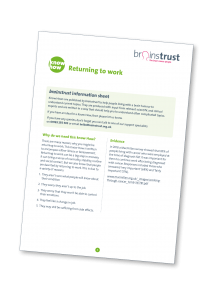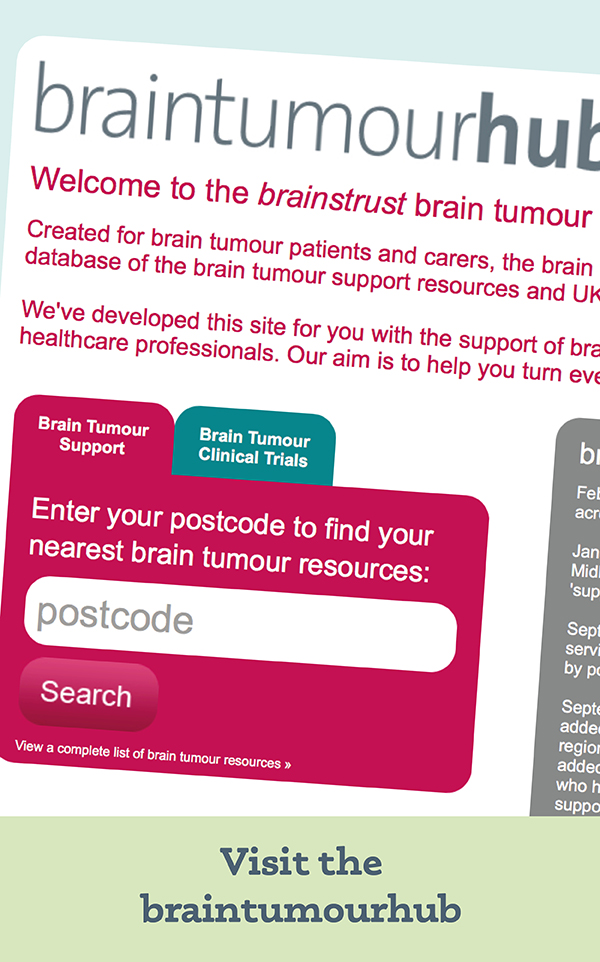Your brain tumour and work
Whether you have a brain tumour and your ability to work has been affected by your diagnosis, or you need time off to look after a loved one, changes to your work-life can be complicated and have a big impact on your mental health. You may be wondering ‘can you work with a brain tumour?’ ‘what do I do if I can’t work?’ ‘how do I go about returning to work?’. There is lots of information and support that you can access to feel more informed and in control.
On this page you will find:
Working before or after treatment
From the point of diagnosis, you may want to think about your options for working and education. Many people choose to work around treatment – returning to work as soon as they feel able to after treatment. People with brain tumours may face issues that may make continuing to work or returning challenging. These might include:
- Fatigue
- Cognitive deficits (concentration)
- Behaviour and personality change
- Mobility issues
- Memory problems
Some may take longer to return to work, or change the type of work they do. Some people may never return at all, due to personal choice or because they are unable to. This can be a big change and a decision that might not come easily. It can be difficult to accept if you’re unable to return to work, but we can help you find a way forward. If this is something you’re struggling with, get in touch.
If you’re thinking about your options around work, here are some questions that might be useful to ask yourself:
- What do you enjoy about working?
- What do you need from work? Is the structure and purpose of your work important to you?
- What adjustments might need to be made for you to return to work?
- What can I afford?
- What benefits could I receive if I stopped working? Check out our Know How on Finances and Benefits. You can also access excellent information about benefits from Maggie’s centres.
- What conversations do I need to have with managers/HR /colleagues, and how often?
- What support might I need from friends and family to continue to work?
Returning to work
Returning to work can be a big step in recovery. It can bring a sense of normality, stability, routine and social contact. But we also know that it can be very daunting. This Know How will help you to prepare for returning to work, understand what help is available to you.
It has been written to encompass returning to work after bereavement as well as illness.
Your rights
If you’ve been diagnosed with cancer, this is regarded as a disability by The Equality Act 2010, and you are protected from discrimination at work. This means that reasonable adjustments have to be made if you choose to continue to work there. You can find out more about your rights from these websites:
You may also be able to get additional support to do your job through the Access to Work scheme.

Access to work
Signs, symptoms and effects of your brain tumour could entitle you to support from the government’s Access to Work scheme. The scheme can help you pay for things that may enable you to access work or do your job if you need things that are beyond reasonable adjustments.
If you have complex work needs, you can ask your clinical nurse specialist for a referral to specialist vocational rehabilitation services.
If your brain tumour diagnosis is causing you to worry about your finances, click here to find out what support is available to you.
Voluntary work
Volunteering can help to build on your skills and confidence, whether you are between jobs, gearing up to full-time work or have chosen to leave a paid role. Even if you have a disability as a result of your brain tumour or treatment, you should still be able to access these roles. You can find out more about volunteering on the Government website. The SCOPE website has lots of useful information for people with a disability.
We are always looking for enthusiastic volunteers at brainstrust to help us help people with a brain tumour feel less alone and better supported. Get in touch here.
Information for employers
If someone you employ has a brain tumour, there will be a lot to think about to ensure that you both feel informed and supported. It is worth catching up with your colleague regularly so that you can help with any adjustments and transitions. Macmillan have a fantastic new toolkit to provide guidance and practical tips for you and your employees – you can find out more here.
Your employee may be able to benefit from the government’s Access to Work scheme, which can sometimes pay for practical support to help your employee do their job, or access work more easily. Check out this helpful Access to Work Factsheet for employers.







